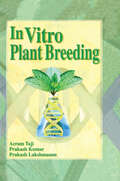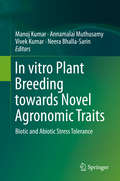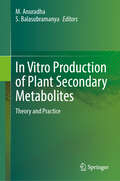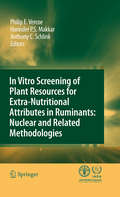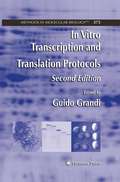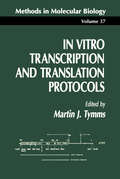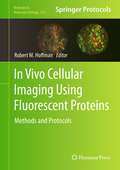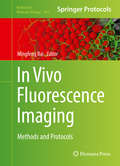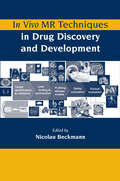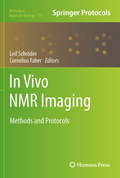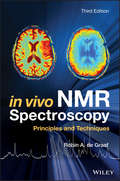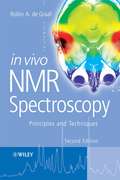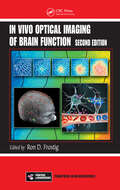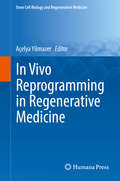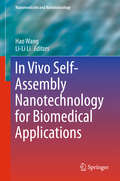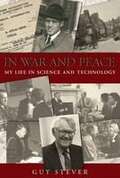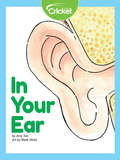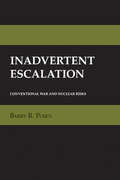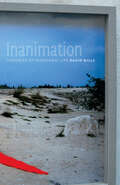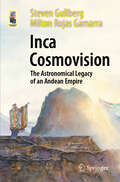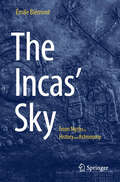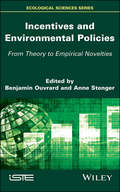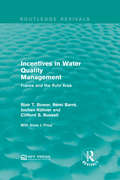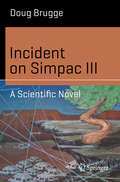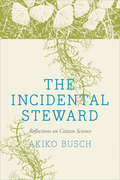- Table View
- List View
In Vitro Plant Breeding
by Acram Taji Prakash Kumar Prakash LakshmananCreate improved crops with these techniques for plant cell culture!This comprehensive book presents the basic concepts and applied techniques of plant cell and tissue culture. More and more, commercial plant breeding and development employs these methods to protect crops from weather, pests, and disease. Covering the history of in vitro breeding as well as emerging research trends, In Vitro Plant Breeding offers specific techniques for crop improvement and breeding.Designed as a text for undergraduate students, In Vitro Plant Breeding presents the theory of tissue culture as well as practical techniques. Its step-by-step instructions and clear illustrations facilitate learning and laboratory work. In Vitro Plant Breeding gives in-depth information and the latest research on the vital concepts and techniques of in vitro breeding, including: applications of plant tissue culture morphogenesis and organogenesis micropropagation producing haploid plants in vitro in vitro pollination and fertilization problems of embryo culture somatic hybridization protoplast technology selection of desirable traits cryopreservation and plant breeding micrografting This helpful book is plentifully illustrated with examples, schematic descriptions, and tables to make the concepts clear and easy to learn. In Vitro Plant Breeding is an essential resource.
In vitro Plant Breeding towards Novel Agronomic Traits: Biotic and Abiotic Stress Tolerance
by Manoj Kumar Annamalai Muthusamy Vivek Kumar Neera Bhalla-SarinThis book presents a comprehensive overview of plant stresses caused by salt, drought, extreme temperatures, oxygen and toxic compounds, which are responsible for huge losses in crop yields. It discusses the latest research on the impact of salinity and global environment changes, and examines the advances in the identification and characterization of the mechanisms that allow plants to tolerate biotic and abiotic stresses. Further it presents our current understanding of metabolic fluxes and the various transporters that collectively open the possibility of applying in vitro technology and genetic engineering to improve stress tolerance. Exploring advanced methods that augment traditional plant tissue culture and breeding techniques toward the development of new crop varieties that can tolerate biotic and abiotic stresses to achieve sustainable food production, this book is a valuable resource for plant scientists and researchers.
In Vitro Production of Plant Secondary Metabolites: Theory and Practice
by M. Anuradha S. BalasubramanyaThis book addresses the literature gap by providing both theoretical foundations and practical insights into in vitro plant secondary metabolite production. It emphasizes the urgency to address the strategies and scientific methods for producing the secondary metabolites in the laboratory conditions. This book includes chapters on various in vitro strategies and laboratory methods, which are crucial for understanding and implementing techniques in this applied field. It equips the readers with the knowledge essential for contributions to pharmaceuticals, agriculture and various industries, thus filling a critical void currently present in the literature and practical applications in this field. This book is structured to cater to a diverse audience, including graduate students and researchers. It is specifically tailored to address the key aspects of plant cell, tissue and organ culture, and aligns seamlessly with the curriculum requirements for the courses offered in plant biotechnology. The modules on cell cultures, secondary metabolite production, and metabolic engineering are also integral components for these courses.
In vitro screening of plant resources for extra-nutritional attributes in ruminants: nuclear and related methodologies
by Harinder P.S. Makkar Anthony C. Schlink Philip E. VercoeThe aim of this manual is to provide a comprehensive guide to the methods involved in collecting, preparing and screening plants for bioactive properties for manipulating key ruminal fermentation pathways and against gastrointestinal pathogens. The manual will better equip the reader with methodological approaches to initiate screening programmes to test for bioactivity in native plants and find 'natural' alternatives to chemicals for manipulating ruminal fermentation and gut health. The manual provides isotopic and non-isotopic techniques to efficiently screen plants or plant parts for a range of potential bioactives for livestock production. Each chapter has been contributed by experts in the field and methods have been presented in a format that is easily reproducible in the laboratory. It is hoped that this manual will be of great value to students, researchers and those involved in developing efficient and environmentally friendly livestock production systems.
In Vitro Transcription and Translation Protocols
by Guido GrandiA highly anticipated update of the previous edition, In Vitro Transcription and Translation Protocols, Second Edition, provides molecular biology laboratories with the most powerful techniques for exploiting in vitro transcription and translation systems. Completely updated with new chapters and topics, there is in-depth analysis of current technologies and applications of in-vitro transcriptions and translations systems. Detailed protocols for protein production using different in vitro transcription and translation systems are included.
In Vitro Transcription and Translation Protocols
by Martin J. TymmsThis book provides molecular biology laboratories with the most powerful techniques for employing in vitro transcription and translation systems. Detailed experimental protocols are provided for prokaryotic transcription and translation systems, along with protocols for the many techniques used in the analysis of eukaryotic transcription. The collection is unique in that it also contains protocols for core techniques that use the products of in vitro transcription and translation systems, such as protein import into mitochondria and chloroplasts and structure-function studies. Also covered are core techniques in the analysis of promoters and transcription factors.
In Vivo Cellular Imaging Using Fluorescent Proteins
by Robert HoffmanThe discovery and genetic engineering of fluorescent proteins has revolutionized cell biology. What was previously invisible in the cell often can be made visible with the use of fluorescent proteins. In Vivo Cellular Imaging Using Fluorescent Proteins: Methods and Protocols presents state-of-the-art research that has contributed to the fluorescent protein revolution to visualize biological processes in the live animal. This volume covers an array of topics from the employment of the chick CAM model using fluorescent proteins and other fluorescent probes, to intravital fluorescent imaging, as well as 3-dimensional imaging, and design instructions on how to create new and improved far-red and infrared fluorescent proteins, to name a few. Written in the successful Methods in Molecular BiologyTM series format, chapters include introductions to their respective topics, lists of the necessary materials and reagents, step-by-step, readily reproducible protocols, and notes on troubleshooting and avoiding known pitfalls. Authoritative and easily accessible, In Vivo Cellular Imaging Using Fluorescent Proteins: Methods and Protocols is the first volume in the new field of in vivo cell biology and it serves both professionals and novices with its well-honed methodologies.
In Vivo Fluorescence Imaging
by Mingfeng BaiThis detailed volume includes a rich variety of applications using various instrumentations, probes, disease models, and targets in order to account for the multidisciplinary nature of the use of in vivo fluorescence imagine. The book also includes chapters on the emerging fields of cell tracking, image-guided treatment, and fluorescence imaging in the second NIR window, as well as protocols for evaluation methods before and after in vivo imaging. Written for the highly successful "Methods in Molecular Biology" series, chapters include brief introductions to their respective topics, lists of the necessary materials and reagents, step-by-step readily reproducible laboratory protocols, and tips on troubleshooting and avoiding known pitfalls. Authoritative and practical, "In Vivo Fluorescence Imaging: Methods and Protocols "serves as a valuable reference for researchers from numerous fields who wish to become more familiar with in vivo fluorescence imaging techniques.
In Vivo MR Techniques in Drug Discovery and Development
by Nicolau BeckmannImaging technologies are receiving much attention in the pharmaceutical industry because of their potential for accelerating drug discovery and development. Magnetic Resonance (MR) Imaging is one of the principal modalities since it allows anatomical, functional, metabolic, and to a certain extent even target-related information to be gathered in v
In vivo NMR Imaging
by Leif Schröder Cornelius FaberNuclear magnetic resonance imaging represents a technique that is indispensable in every day biomedical diagnostics. Thanks to the numerous ways to manipulate and detect an NMR signal, it is possible to obtain a variety of information with excellent spatial and temporal resolution. Today's MRI techniques go far beyond the illustration of pure anatomical structures and include the revealing of processes down to the molecular level. The number of small animal imaging centers relying on MRI as a key method for preclinical research to understand diseases and to test for novel treatments is growing rapidly. In Vivo NMR Imaging: Methods and Protocols is written as an experimental laboratory text to provide a descriptive approach of the various applications of magnetic resonance imaging and its underlying principles. Starting from a compact introduction of basic NMR physics and image encoding techniques suitable for a broad audience in the life sciences, the concept focuses on addressing the many ways of generating contrast in MR images. The authors cover an interdisciplinary range of problems to be addressed by this non-invasive modality, including study protocols for addressing morphological, physiological, functional, and biochemical aspects of various tissues in living organisms. Information about practical aspects of designing experimental studies that follow the special conditions for micro imaging setups are also provided. Written in the successful Methods in Molecular BiologyTM series format, In Vivo NMR Imaging: Methods and Protocols aims to be an experimental compendium of modern in vivo MR imaging with special focus on recent developments in molecular imaging and new protocols for imaging metabolism and molecular markers.
In Vivo NMR Spectroscopy: Principles and Techniques
by Robin A. de GraafPresents basic concepts, experimental methodology and data acquisition, and processing standards of in vivo NMR spectroscopy This book covers, in detail, the technical and biophysical aspects of in vivo NMR techniques and includes novel developments in the field such as hyperpolarized NMR, dynamic 13C NMR, automated shimming, and parallel acquisitions. Most of the techniques are described from an educational point of view, yet it still retains the practical aspects appreciated by experimental NMR spectroscopists. In addition, each chapter concludes with a number of exercises designed to review, and often extend, the presented NMR principles and techniques. The third edition of In Vivo NMR Spectroscopy: Principles and Techniques has been updated to include experimental detail on the developing area of hyperpolarization; a description of the semi-LASER sequence, which is now a method of choice; updated chemical shift data, including the addition of 31P data; a troubleshooting section on common problems related to shimming, water suppression, and quantification; recent developments in data acquisition and processing standards; and MatLab scripts on the accompanying website for helping readers calculate radiofrequency pulses. Provide an educational explanation and overview of in vivo NMR, while maintaining the practical aspects appreciated by experimental NMR spectroscopists Features more experimental methodology than the previous edition End-of-chapter exercises that help drive home the principles and techniques and offer a more in-depth exploration of quantitative MR equations Designed to be used in conjunction with a teaching course on the subject In Vivo NMR Spectroscopy: Principles and Techniques, 3rd Edition is aimed at all those involved in fundamental and/or diagnostic in vivo NMR, ranging from people working in dedicated in vivo NMR institutes, to radiologists in hospitals, researchers in high-resolution NMR and MRI, and in areas such as neurology, physiology, chemistry, and medical biology.
In Vivo NMR Spectroscopy
by Robin A. de GraafThis is the second edition of a unique book in the field of in vivo NMR covering in detail the technical and biophysical aspects of the technique.The contents of the book are appropriate to both beginners and experienced users of in vivo NMR spectroscopy. The new edition is focussed on bringing the reader practical insights and advice, but is also geared towards use as a study aid and in NMR courses. Recent advances in NMR spectroscopy, like high field NMR, hyperpolarized NMR and new localization and editing techniques have been included. An extensive and updated treatment of radiofrequency pulses is given, together with several tables and recipes for their generation.Solutions to the exercises within this text can be found here
In Vivo Optical Imaging of Brain Function
by Ron D. FrostigThese are exciting times for the field of optical imaging of brain function. Rapid developments in theory and technology continue to considerably advance understanding of brain function. Reflecting changes in the field during the past five years, the second edition of In Vivo Optical Imaging of Brain Function describes state-of-the-art techniques a
In Vivo Reprogramming in Regenerative Medicine
by Açelya YilmazerThis new volume reviews current progress on different approaches of in vivo reprogramming technology. Leaders in the field discuss how in vivo cell lineage reprogramming can be used for tissue repair and regeneration in different organs, including brain, spinal cord, pancreas, liver and heart. Recent studies on in vivo cell reprogramming towards pluripotency are reviewed; examples are given to show its potential in regenerative medicine. In each chapter, the regenerative potential of different in vivo reprogramming approaches is discussed in detail. More specifically, how different tissue failures or damages can be treated with this technology is explained. Examples from various animal models are given and the regenerative potential of in vivo reprogramming is compared to that of cell transplantation studies. The last chapter discusses current challenges of these preclinical studies and gives suggestions in order to improve the current strategies. Future directions are indicated for the transition of in vivo reprogramming technology to clinical settings. This is among the first books in the literature which specifically focuses on the in vivo reprogramming technology in regenerative medicine and these chapters collectively cover one of the most important and exciting topics of regenerative medicine.
In Vivo Self-Assembly Nanotechnology for Biomedical Applications
by Hao Wang Li-Li LiThis book reviews and discusses the development of self-assembled nanomaterials applied in biomedical fields. Based on self-assembled nanomaterial constructions, it highlights the mechanisms of the stimuli-response-induced assembly/disassembly and transformation. Moreover, it examines healthcare-related diseases, the applications of nanomaterials and therapy/detection strategies, providing readers with both a deeper understanding of the subject and inspirations for future research. The book is primarily intended for researchers and graduate students in the fields of material sciences and chemistry who wish to learn about the principles, methods, mechanisms and biomedical applications of self-assembled nanomaterials.
In War And Peace: My Life In Science And Technology
by Guy SteverScience came into Guy Stever’s life as a pure and peaceful pursuit. It was only later, as he walked through the wreckage of wartime London that he began to see science as central to a desperate struggle to survive.Past president of Carnegie Mellon University, former Chief Scientist of the U.S. Air Force, one-time Director of the National Science Foundation, professor at MIT for 20 years, member of the National Academies of Sciences and Engineering, and science advisor to two presidents…Guy Stever was a central figure in twentieth century science—consistently on the front lines, changing the fate of a nation.In this thoughtful and candid memoir, Stever recounts an extraordinary life that reveals as much about the man as about the major scientific and technological events of his day. Born of humble origins and orphaned at an early age, Stever journeyed from a small town in New York to work alongside British comrades who were developing and refining the critical radar technology that was to turn the tide of the war against the Germans. As a technical intelligence officer, these harrowing wartime years took him from the beachheads of Normandy to the German slave-labor factories responsible for building the V-2 rockets.Stever returned home committed to serving his country. He became intimately involved in America’s nascent guided missile program—and was to remain a key player in the anti-ballistic missile defense program that heralded the era of the Cold War. As the decades passed, Stever continued to exert lasting influence on countless scientific endeavors. He was instrumental in the formation of new institutions, from the creation of NASA in the post-Sputnik years to the merging of Carnegie Tech and the Mellon Institution, giving birth to Carnegie Mellon University. As Presidential Science Advisor to both Nixon and Ford, Stever shaped the very structure of contemporary presidential science advising. And he was to chair the oversight committee that redesigned the space shuttle boosters after the Challenger explosion.Guy Stever’s life offers remarkable insight into the twentieth century. Through his eyes, we relive the history of the past 50 years, witnesses to a tale of science and technology that is revealing in its scope and sweep.
In Your Ear
by Amy TaoDo you know how your ears can hear? Learn about the anatomy of your ear and how its structure allows you to hear all the different noises you experience every day!
Inadvertent Escalation
by Barry R. PosenIn this sobering book, Barry R. Posen demonstrates how the interplay between conventional military operations and nuclear forces could, in conflicts among states armed with both conventional and nuclear weaponry, inadvertently produce pressures for nuclear escalation. Knowledge of these hidden pressures, he believes, may help some future decision maker avoid catastrophe. Building a formidable argument that moves with cumulative force, he details the way in which escalation could occur not by mindless accident, or by deliberate preference for nuclear escalation, but rather as a natural accompaniment of land, naval, or air warfare at the conventional level. Posen bases his analysis on an empirical study of the east-west military competition in Europe during the 1980s, using a conceptual framework drawn from international relations theory, organization theory, and strategic theory. The lessons of his book, however, go well beyond the east-west competition. Since his observations are relevant to all military competitions between states armed with both conventional and nuclear weaponry, his book speaks to some of the problems that attend the proliferation of nuclear weapons in longstanding regional conflicts. Optimism that small and medium nuclear powers can easily achieve "stable" nuclear balances is, he believes, unwarranted.
Inanimation: Theories of Inorganic Life (Posthumanities #35)
by David WillsInanimation is the third book by author David Wills to analyze the technology of the human. In Prosthesis, Wills traced our human attachment to external objects back to a necessity within the body itself. In Dorsality, he explored how technology is understood to function behind or before the human. Inanimation proceeds by taking literally the idea of inanimate or inorganic forms of life. Starting from a seemingly naïve question about what it means to say texts &“live on&” or have a &“life of their own,&” Inanimation develops a new theory of the inanimate.Inanimation offers a fresh account of what life is and the ethical and political consequences that follow from this conception. Inspired by Walter Benjamin&’s observation that &“the idea of life and afterlife in works of art should be regarded with an entirely unmetaphorical objectivity,&” the book challenges the coherence and limitations of &“what lives,&” arguing that there is no clear opposition between a live animate and dead inanimate. Wills identifies three major forms of inorganic life: autobiography, translation, and resonance. Informed by Jacques Derrida and Gilles Deleuze, he explores these forms through wide-ranging case studies. He brings his panoptic vision to bear on thinkers (Descartes, Freud, Derrida, Benjamin, Carl Schmitt, Jean-Luc Nancy, Roland Barthes), writers and poets (Hélène Cixous, Paul Celan, William Carlos Williams, Ernst Jünger, James Joyce, Georges Bataille), and visual artists (Jean-François Millet, Jean-Luc Godard, Paul Klee). With panache and gusto, Wills discovers life-forms well beyond textual remainders and translations, in such disparate &“places&” as the act of thinking, the death drive, poetic blank space, recorded bird songs, the technology of warfare, and the heart stopped by love.
Inca Cosmovision: The Astronomical Legacy of an Andean Empire (Astronomers' Universe)
by Steven Gullberg Milton Rojas GamarraThe Inkas (Quechua spelling) worshipped the Sun, and their emperor was thought to be the son of the Sun. They conquered most of the Andes and their former empire is replete with examples of their astronomy. They used solar positions on the horizon for calendrical purposes and managed their crops and religious festivals in this manner. Many examples remain of their intentional light and shadow effects that demonstrate their sophisticated understanding of the Sun’s movement and of solar horizon events. Evidence of their astronomy can only be fully understood in its cultural context, and that is the focus of this book. Inka Cosmovision explores the cosmic worldview of the Inkas from the perspective of oral traditions passed from one generation to the next among the Inkas’ living descendants. You will learn about Inka astronomy in a way that you perhaps have never encountered. An author of the book is Quechua, a descendant of the Inkas, and what you will read benefits greatly not only from the field research of both authors, but from the many stories he learned from his parents and grandparents and from his Amauta, a highly respected Indigenous teacher of Inka culture. This book enlightens about Inka cosmovision as no other has before.
The Incas' Sky: From Myths to History and Astronomy
by Émile BiémontThis book introduces readers to the astonishing civilisation of the Incas. Its novelty lies in its general but highly informative synthesis of their history and astronomy through the accounts of contemporary chronicles and recent archaeological findings. Richly illustrated with the author’s own photographs, it will attract the attention of seasoned travellers interested in ancient civilisations and keen to discover what people were capable of achieving so long ago, but also any reader interested in the history and prehistory of South American peoples, including students or university researchers wanting to know more about the pre-Columbian civilizations of Peru. The Inca civilisation was in fact the culmination of cultural contributions from a dozen or so complex pre-Columbian civilizations, such as those of Chavín, Nazca, Wari, or Tiwanaku. Intensely spiritual, the Inca people attributed metaphysical powers to all manner of objects and places they considered sacred, but at the same time the numerous alignments in their buildings show that they result from careful observations of the Sun, the Moon, and the stars at different times of the year. Indeed, the Incas were an essentially agrarian people, so time measurement and calendar devices were essential for the purely pragmatic problem of planning agricultural tasks during the tropical year. The book sets out to describe the Incas in their historical and geographical context, avoiding specialization or excessive technicality, but retaining a certain scientific rigor, and including a detailed consideration of their interest in the sky and astronomy.
Incentives and Environmental Policies: From Theory to Empirical Novelties
by Benjamin Ouvrard Anne StengerThe economic protection of the quality of the environment took shape properly in the middle of the 20th Century when various economic instruments were proposed to policymakers. Today, protecting the environment is essential, as evidenced in the rise in temperatures, the melting of the icecaps, the disappearance of animal species, etc. Moreover, with recent advances in other disciplines (notably in psychology), economists are turning more and more towards non-monetary forms of incentive. However, questions concerning the effectiveness of these forms arise.Incentives and Environmental Policies deals with the role of the economy in protecting the environment by revisiting traditional economic instruments and pursuing an advanced consideration of the role of new forms of incentive. It appears that, in order to strive towards the best possible environmental quality, policymakers will have to take into account the future of many combinations of socially acceptable incentives.
Incentives in Water Quality Management: France and the Ruhr Area (Routledge Revivals)
by Blair T. Bower Rémi Barré Jochen Kühner Clifford S. RussellIncentives in Water Quality Management explores the role of effluent charges in France and the Ruhr area of the federal republic of Germany by delving into both regulatory and economic systems that are utilised in the water quality management of these two areas. Originally published in 1981, these studies place an emphasis on the necessity of legislation in effective water quality management whilst attempting to create a complete picture of the water quality management systems in place in France and the Ruhr area. This title will be of interest to students of Environmental Studies.
Incident on Simpac III: A Scientific Novel (Science and Fiction)
by Doug BruggeA few hundred years into the future, a wave of space colonization follows a disastrous earlier attempt to inhabit nearby extrasolar planets. It is guided by a new computational method based on massive data-driven socio-cultural and socio-epidemiological modeling and using novel biological computers, fed with data on Earth’s history of successes and failures. Yet, in the newly settled Simpac system, some unexpected and worrying anomalies begin cropping up, making an urgent expedition to the system necessary: is it the underlying data, the computations, or is some unknown entity tampering with the space colonization program? A race against time ensues as the lives of four strangers begin to converge. While grounded in the social systems aspect, the author posits that the future is likely to be characterized by more biology-based tools than most contemporary science fiction – which most often relies entirely on non-biological hardware in terms of advanced technologies – predicts. The result is an entertaining and skillful blend of thriller and SF, complemented by a nontechnical appendix describing the underlying science.
The Incidental Steward: Reflections on Citizen Science
by Akiko BuschA search for a radio-tagged Indiana bat roosting in the woods behind her house in New York's Hudson Valley led Akiko Busch to assorted other encounters with the natural world--local ecological monitoring projects, community-organized cleanup efforts, and data-driven citizen science research. Whether it is pulling up water chestnuts in the Hudson River, measuring beds of submerged aquatic vegetation, or searching out vernal pools, all are efforts that illuminate the role of ordinary citizens as stewards of place. In this elegantly written book, Busch highlights factors that distinguish twenty-first-century citizen scientists from traditional amateur naturalists: a greater sense of urgency, helpful new technologies, and the expanded possibilities of crowdsourcing. The observations here look both to precisely recorded data sheets and to the impressionistic marginalia, scribbled asides, and side roads that often attend such unpredictable outings. While not a primer on the prescribed protocols of citizen science, the book combines vivid natural history, a deep sense of place, and reflection about our changing world. Musing on the expanding potential of citizen science, the author celebrates today's renewed volunteerism and the opportunities it offers for regaining a deep sense of connection to place.
